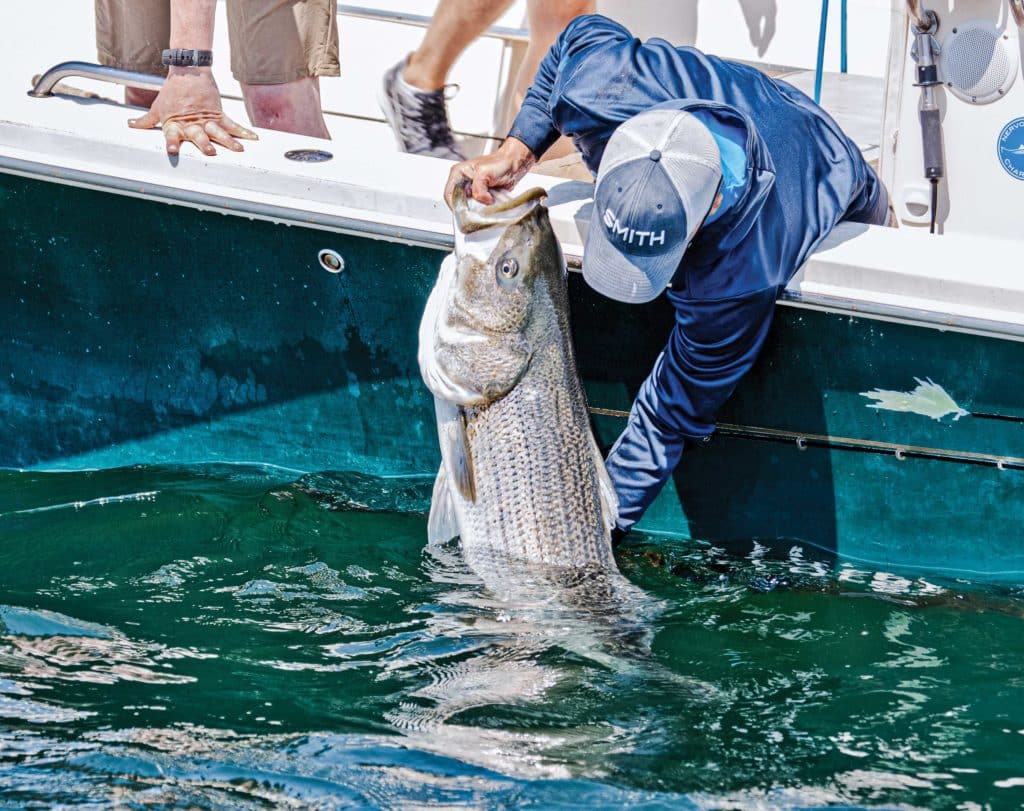
On a winter day in 1985, my father pulled me out of school to go bluefishing at Island Beach State Park in New Jersey. We knew better than to expect a striped bass because they were almost extinct during those years. We rigged an 11-foot fiberglass rod, baited a 4/0 bait-holder J hook with clams on a high-low rig, and tossed it into the roiling surf. After an hour, the rod tap-tapped, then went down hard. I was astounded when I reeled in a 26-inch striper. We looked at each other as if we were seeing a ghost. A striped bass? From the surf?
Catching a surf striper—or a striper anywhere—may not be a feat nowadays, but in the ’80s, that was a catch of note. The question is, could the near extinction of bass happen again?
Bass History
During the 1980s, striped bass stocks were severely depleted due to poor recruitment, commercial overfishing, and likely some recreational impact. Luckily, regulations were put in place, both on the federal and state levels, going so far as to institute a moratorium on the fishery in Chesapeake Bay from 1985 to 1989.
Striper stocks rebounded, and fishing peaked in the 2000s, a heyday for the fishery and anglers. But pressure on the broodstock in the recent decade, among other factors, has striper stocks again on a downward trend. Efforts are now afoot to forestall another dire situation.
Circling Back
As of January 1, 2021, new regulations hold promise. Along most of the East Coast, anyone fishing with live or dead natural bait must use a non-offset (inline) circle hook. The traditional snag-and-drop—snagging a live bunker with a weighted treble, then waiting for a striper to grab it—is no longer legal, but you can snag a bunker, land it, and rerig it with a circle hook.
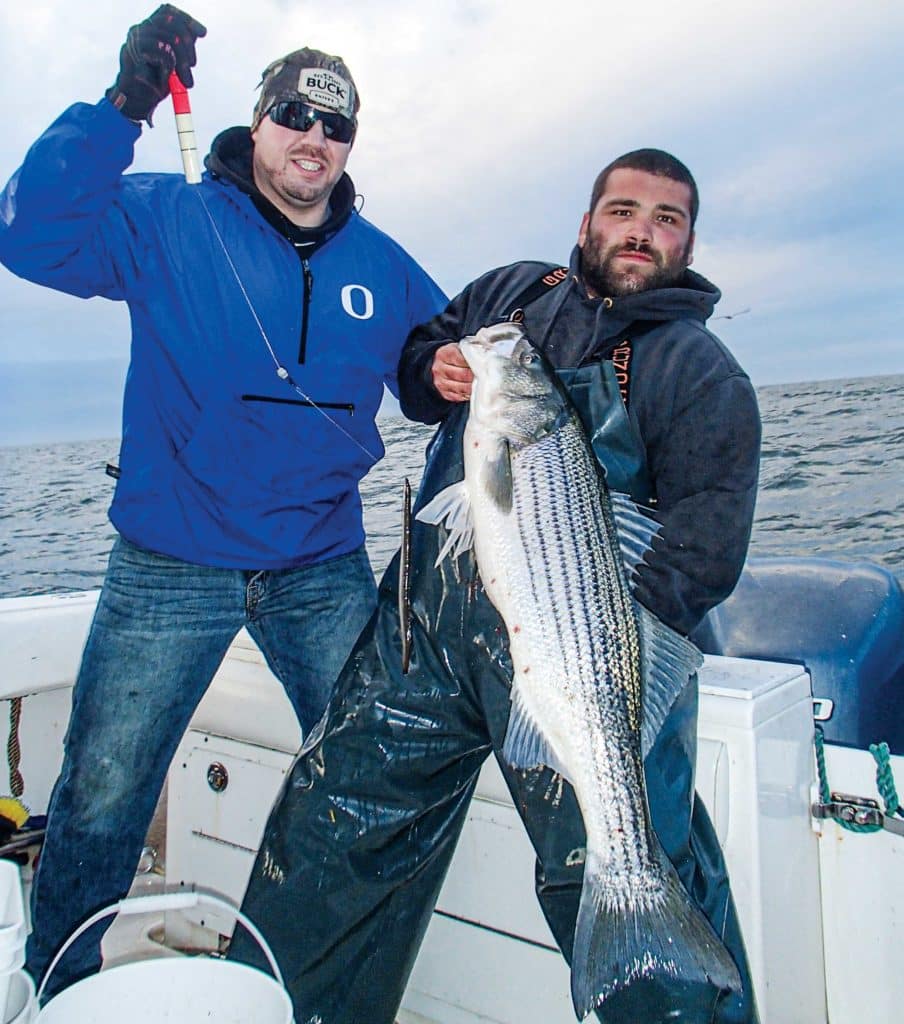
Other rigs and lures that have historically used J hooks—tube and worm, eel-skin rig, rigged eel, pork rind, or squid sweeteners on a bucktail jig—now must incorporate a non-offset circle hook.
The Eel Deal
Chuck “Tyman” Many has targeted trophy stripers for most of his life. Live-lining eels and bunker, he became the undisputed striper king, claiming 19 bass over 50 pounds since this past December alone.
With J hooks outlawed, he changed his strategy.
“I’m a catch-and-release guy and never set out to keep any bass,” Many says. “With circle hooks, I don’t see much of a change in the bass that hit, but we have to hook the fish differently.”
He usually slow-trolls eels for his trophy fish using 8/0 Gamakatsu Octopus circle hooks, hooking the eel upward through the lips. “When a fish hit, we used to set the hook immediately, but not anymore.” Many says he now leaves the rod in the rod holder until the fish on the line pulls drag.
That slow, steady pressure pulls the circle hook into the corner of the fish’s mouth, where it lodges itself. “I set the drags light for the hook-set, then we dial up the drag pressure during the fight,” he says.
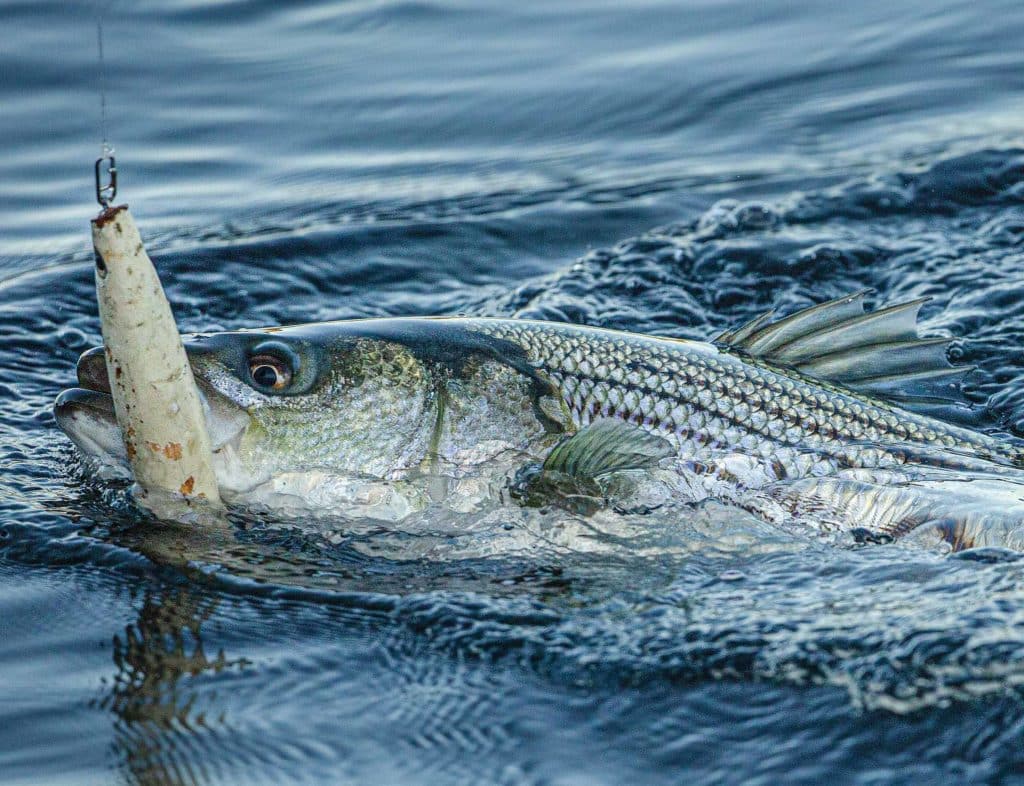
When drifting bigger baits such as live or chunked bunker, Many has adopted a gentle hook-set. “I set the drag loose, let the fish run, then lift the rod upward and start reeling if the fish is below the boat, or pull the rod sideways and up if the fish is behind the boat.
“Don’t reel crazy fast. Lift the rod and reel normally. When the fish feels resistance, it will run, and that sets the hook. Then adjust the drag to put pressure on the fish.”
Worms, Clams and Chunks
Capt. Phil Sciortino of the Tackle Box in Hazlet, New Jersey, caters to anglers fishing Raritan Bay with sandworms, bloodworms, clams and bunker chunks on 3/0 to 4/0 circle hooks. “High-low rigs or three-way swivel rigs with anchored weights are impractical now,” he says. “The shift is toward short-leader, fish-finder slider rigs.” The fish-finder slider rig consists of a sliding-sinker clip on the main line, a 75-pound barrel swivel, and a short 16-inch, 40-pound fluorocarbon leader to the hook.
“The slider lets the fish run off with the bait. Then you just lower the rod, let the fish run, and lift the tip.”
To prevent short bites when worming, anglers use the worm ball. “Thread the first worm up the shank, then hook two or three worms through the head. Let them hang, flip them twice over the shank of the hook, tie them on with elastic, and add a drop of Fin-Essence oil. The more bait and scent on the hook, the better they take it,” Sciortino says.
Anglers tossing or drifting with bunker chunks and clams also benefit from slider rigs, though it’s critical to ensure the hook point and barb pass completely through the bait; otherwise, the circle hook won’t set.
“The hardest habit for striper fishermen to overcome will be to avoid striking on the first or second nibble. We used to set the hook quickly to prevent a swallowed bait, but now it’s kind of counterintuitive; you want the bass to take the bait completely. Patience is a key factor in success,” Sciortino says.
Hit the Slots
Striped bass size and bag limits have changed dramatically. In most of the East Coast, anglers are now allowed to keep one fish of 28 to 35 inches, but regs may vary in individual states. In New Jersey, the legal slot is between 28 and 38 inches, and restrictions in Chesapeake Bay and spawning rivers along the East Coast may vary as well.
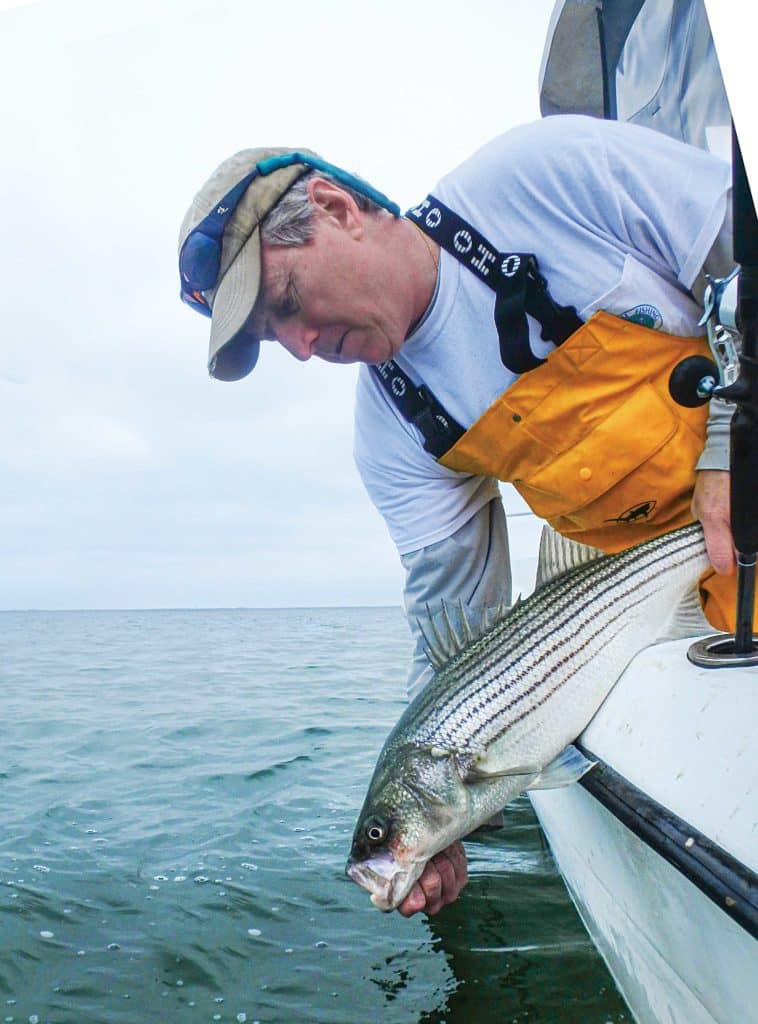
Prior to 2020, bag limits in most Northeast and mid-Atlantic states had a negative impact on breeder-size fish.
The new slot limits take into account that male stripers mature at two or three years old (16 to 20 inches in length) and females in four to eight years (24 to 32 inches), and are designed to preserve mature males and the biggest, most productive breeding females (those over 40 inches) to protect a broad swath of the breeding population.
Keep ‘Em Strong
A successful low-impact, live release is critical to keeping populations of the critical breeder-size fish healthy.
Many offers a couple of tips for releasing under- and over-slot-size fish so they have the best chance of surviving uninjured.
“Scoop them with a rubber mesh net, which protects the slime layer on striped bass and is gentler than nylon. If you are keeping a striper, have a ruler ready to measure it quickly and determine if it is legal.”
Lastly, dehook quickly, using strong pliers or a dehooker to dislodge the circle hook because it will be planted firmly in the cartilage of the jaw.
Listen, it’s not an emergency situation yet. Stripers are still fairly abundant. With more studies year after year, we can get ahead of the problem before it becomes a serious dilemma.
Time will tell if the new regulations have a positive effect on the populations. Adopting circle hooks and slot limits is a step in the right direction.
Circle-Hook Mechanics
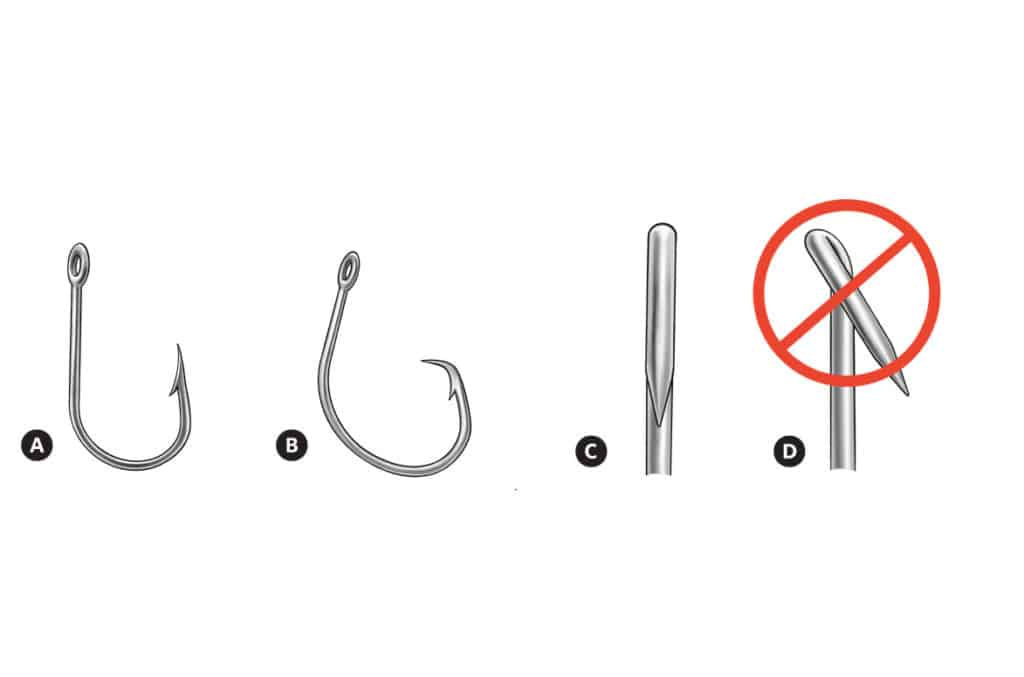
A J hook, A, will set anywhere. When a fish takes a natural bait on a J hook, lip-hooking is not certain. The fish is just as likely to be hooked in the throat, gill arches or gullet, all of which are bad news for a healthy release.
The inline circle hook, B, with its rolled point directly above the hook shank, C, cannot catch on a smooth surface, such as inside the mouth or the gullet. Even if the fish takes it deeply, the steady pull of the fish moving away slides the hook forward. When it reaches the corner of the jaw and rotates, the point gains purchase and sets firmly, ensuring an uninjured fish. Offset circle hooks, D, are not legal with natural bait.
Planner
What: Striped bass
Where: Eastern Seaboard, from Maine to North Carolina
Who: These experts can show you the ropes:
- Chuck “Tyman” Many, 908-303-0271
- Capt. Phil Sciortino, 732-264-7711
Tackle Box
Hooks: Gamakatsu 8/0 to 10/0 non-offset circle hooks for eels and bunker; size 2/0 to 4/0 non-offset circle hooks for clams and worms
Rods: 6 1/2- to 7-foot, moderate to heavy spinning or conventional rated for 30- to 50-pound-test line
Reels: 6000-class spinning; 16- to 20-class conventional, like Shimano Torium or equivalent









